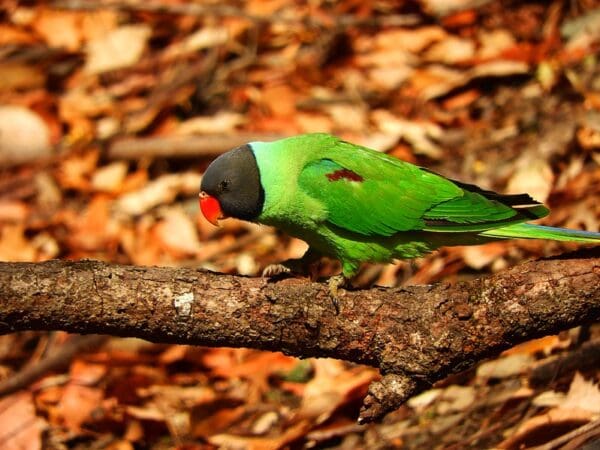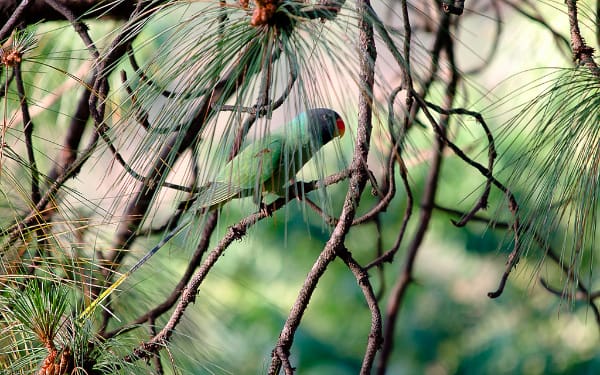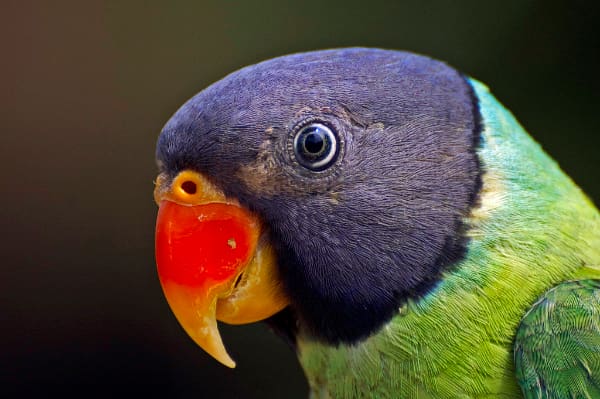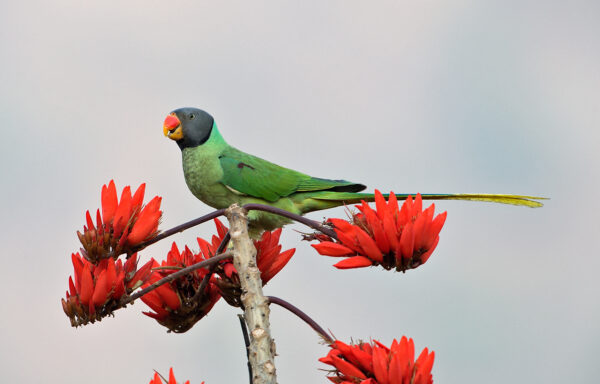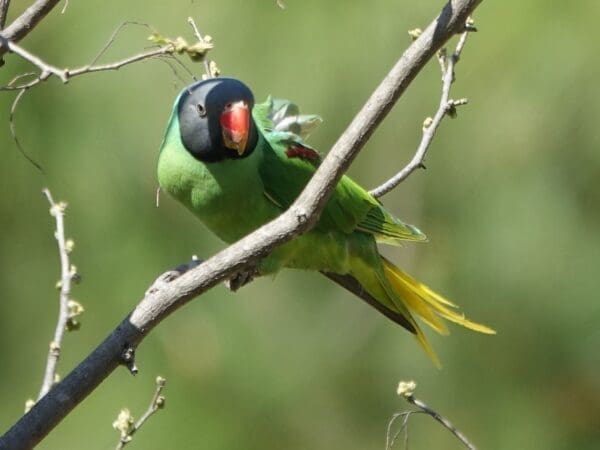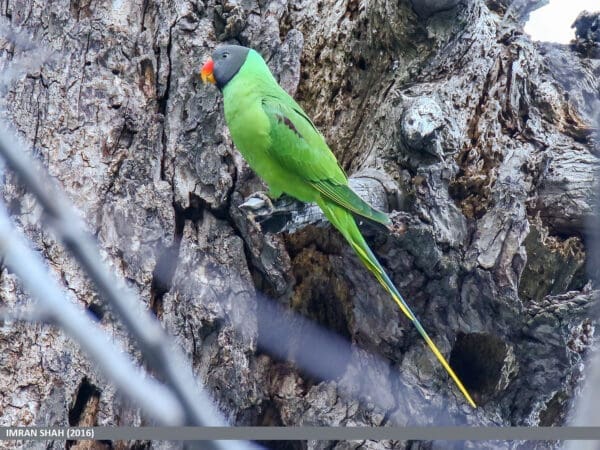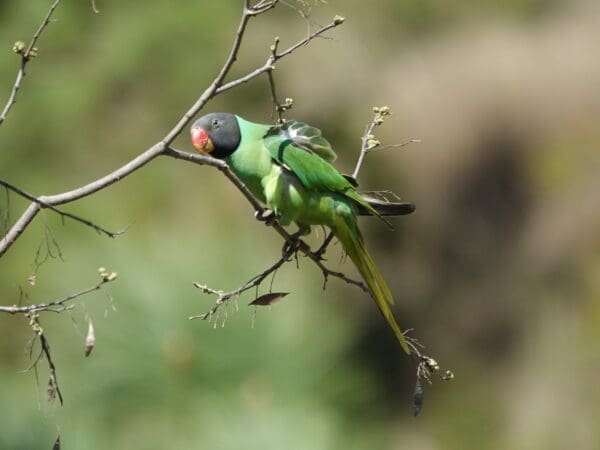Slaty-headed Parakeet
Also known as:
Himalayan Slaty-headed Parakeet, Hodgson's Parakeet
Also known as:
Himalayan Slaty-headed Parakeet, Hodgson's Parakeet
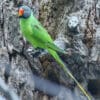
![© Sumita Roy Dutta [CC BY-SA 4.0], Wikimedia Commons A wild male Slaty-headed Parakeet perches on a limb](https://parrots.org/wp-content/uploads/2023/01/wpt_Slaty-headed-Parakeet_1284-11-100x100.jpg)
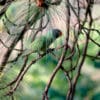
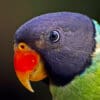
![© Koshy Koshy [CC BY-NC-SA] via Flickr A wild male Slaty-headed Parakeet perches atop a flowering tree](https://parrots.org/wp-content/uploads/1990/12/Slaty-headed-Parakeet-lg-Koshy-Koshy-100x100.jpg)
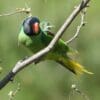
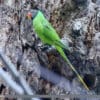
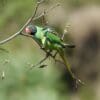
DID YOU KNOW?
In E Afghanistan, the Slaty-headed Parakeet will most often make its nest in an old Scaly-bellied Woodpecker dwelling.

Himalayapsitta

himalayana
Size:
40 cm (15.6 in)
Weight:
125 g (4.4 oz)
Subspecies including nominate:
one
Colour Adult:
Both adults in general green with blue tint; dark grey head with blue tint; black chin and wide stripe across lower cheeks; fine black line around hindneck; band around hindneck under black line green/blue; patch on inner median wing coverts deep maroon in males, missing in females; long central tail feathers in male, shorter in female; green at base of tail becoming deep blue and widely tipped with bright yellow. Red upper mandible, pale yellow lower. Eye pale yellow.
Colour Juvenile:
Grey/green face, remainder of head dull green with faint pale green stripe below cheeks to hindcrown; maroon wing patch absent; short tail. Beak orange. Eye grey.
Call:
Calls made in flight are shrill and high-pitched. High-pitched short notes and prolonged whine while at rest. Also variety of softer, musical sounds.
More Information:
Content Sources:
CITES
BirdLife International
Cornell Lab of Ornithology/Birds of the World
Parrots: A Guide to Parrots of the World, Juniper and Parr, 1998
Parrots of the World, Forshaw and Cooper, 1977. 2010 edition
Parrots of the World, Forshaw, 2006.
Parrots in Aviculture, Low, 1992.
Captive Status:
Fairly common in Australia, less so elsewhere.
Longevity:
About 15-17 yrs
Housing:
Walk-in enclosure, minimum length 3 m (9.8 ft).
Diet:
Small seed mix such as: canary, millet and smaller amounts of oats, buckwheat, safflower and a little hemp; soaked or sprouted sunflower seed; spray millet; green leaves such as: Swiss chard, lettuce, sowthistle, dandelion, chickweed; seeding grasses; rearing food made from: hardboiled egg, wholegrain bread and carrot, all ground to crumbly consistency; fruits such as: apple, pear, banana, orange, cactus fruits, pomegranate; complete pellet.
Enrichment:
Provide bird-safe, unsprayed flowering, fir, pine, elder and willow branches; wooden and vegetable tanned leather toys, ladders, swings, different sized perches and puzzle/foraging toys.
Nest Box Size:
Nest log 10″ x 24″ (25.4 cm x 61 cm).
Clutch Size:
4-5
Fledging Age:
7 weeks
Hatch Weight:
—
Peak Weight:
—
Weaning Weight:
—
World Population:
Unknown, decreasing.
IUCN Red List Status:
Least Concern
CITES Listing:
Appendix II
Threat Summary:
Not globally threatened. Is generally common but poorly documented in recent decades. Is uncommon in China. This species is considered to have a high dependency on forest habitat, and tree cover is estimated to have declined by 0.8% within its mapped range over the past three generations. It is therefore tentatively suspected that this may have led to a population decline of 1-19% over the same time frame, with a best estimate of less than 5%.
Range:
Himalayas from E Afghanistan and N Pakistan east through N India and Nepal to Bhutan, Arunachal Pradesh, and N Assam, north of Brahmaputra River.
Habitat:
Found 460-2400 m (1509-7872 ft) in highland forest, hillside and steep valley woodlands.
Wild Diet:
Feeds on cultivated and wild fruits, nuts, berries, pinenuts, acorns, nectar and seeds.
Ecology and Behaviour:
Generally seen in small flocks or family groups, with larger gatherings recorded at end of monsoon season. Will mix readily with Ringneck, Blossom-headed and Plum-headed Parakeets.
Clutch and Egg Size:
4-5 rounded eggs, 28.5 x 22.0 mm (1.1 x 0.8 in).
Breeding Season:
March-May
Related Links:
—

